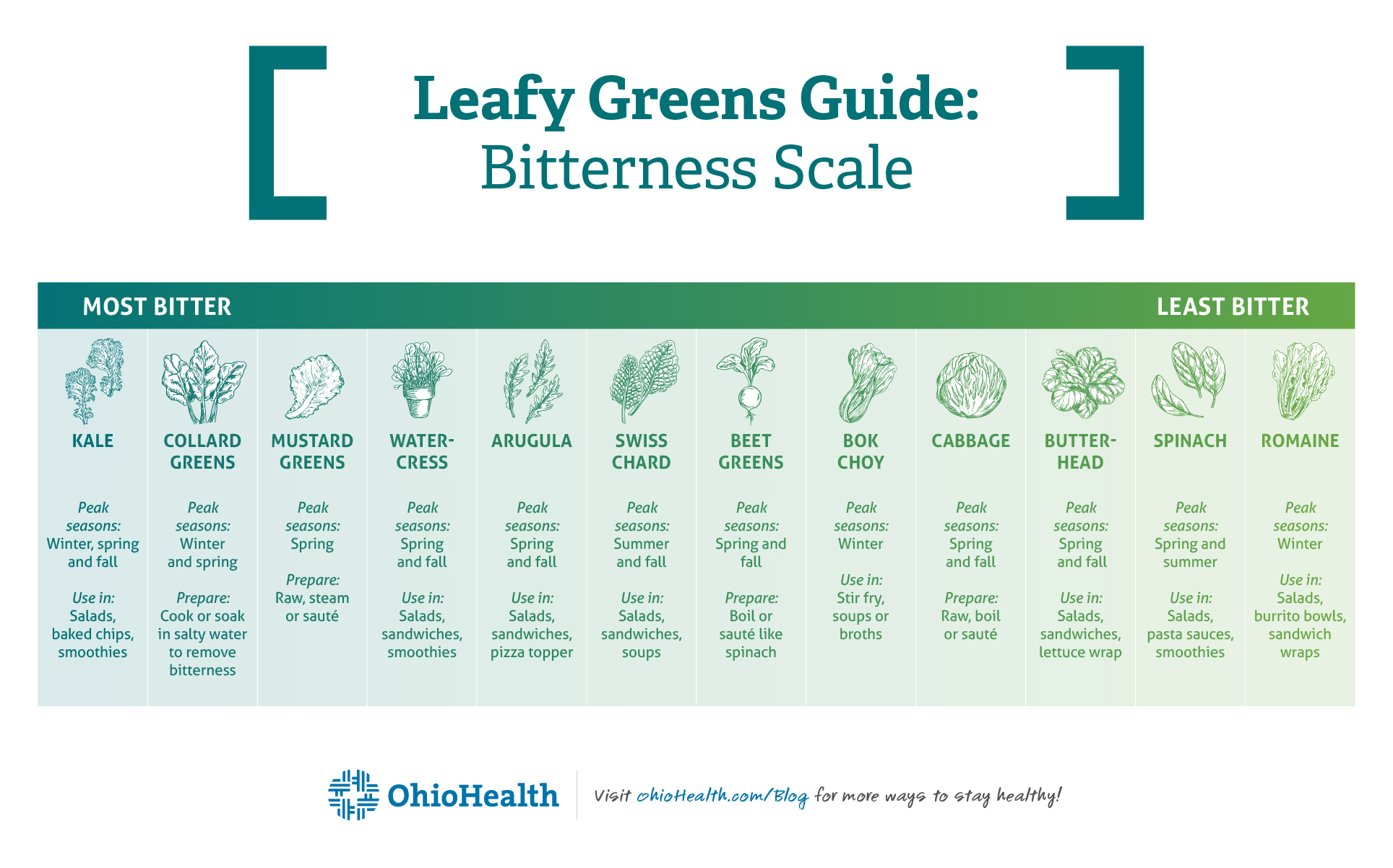When it comes to leafy greens, there’s plenty to choose from – maybe even more than you thought. Each leafy green has their own benefits and tastes, which can make it hard to know which one is best for your needs. From arugula to watercress, we’ve got you covered on everything you need to know about leafy greens.
Arugula
Peak seasons: Spring and Fall
Source of: vitamin A, vitamin K, vitamin C, folate, calcium
Arugula has a peppery, bitter taste, so people frequently mix it with other leafy greens, but it can still be used on its own. Arugula is most frequently used in salads, but it can also be added to a number of dishes, like pasta or on top of pizza, to up the flavor factor. You can add it to sandwiches and wraps to increase overall nutrition, too.
Beet greens
Peak seasons: Spring and Fall
Source of: vitamin E, vitamin A, vitamin C, potassium, iron, calcium
We all know what beets are, but did you know you can actually eat the leaves that grow with them? Beet greens are probably one of the lesser known leafy greens, but they’re still a great option. Like arugula, they are slightly bitter. You can prepare beet greens like spinach or kale by boiling or sautéing them.
Bok choy
Peak season: Winter
Source of: vitamin A, vitamin K, vitamin C, potassium, calcium, magnesium, iron
Bok choy is on the sweeter side of leafy greens and is a popular ingredient in Chinese food because it was first grown there. You don’t have to worry about chopping them if you don’t want to – the entire leaf is edible. Bok choy can be prepared in many ways – you can boil it, sauté it, or add to other dishes like stir fry, soups, or broths.
Butterhead lettuce
Peak seasons: Spring and Fall
Source of: vitamin K, vitamin A, vitamin B6, iron, manganese
You might be able to guess something about this lettuce just from the name – the texture of butterhead lettuce is close to that of butter, which makes it really popular for salads. Like other lettuce, it can be used in tons of ways – sandwiches, soups, or even as a lettuce wrap instead of using a tortilla to help cut down on some calories.
Cabbage
Peak season: Spring and Fall
Source of: vitamin C, vitamin K, magnesium, folate
If you’re looking for something a little crunchier than other leafy greens, try cabbage. You may have already tried cabbage as the star ingredient in coleslaw. Cabbage can be prepared in many ways, such as raw, boiled, sautéed and more. It’s a good addition in salads and soups, but you can also roast it with a few ingredients to keep it simple, yet healthy.
Collard greens
Peak seasons: Winter and Spring
Source of: vitamin A, vitamin C, vitamin K, vitamin B6, calcium, iron, magnesium
Collard greens are on the bitter side, but not as bitter as kale. If you want to cut some of the bitterness, cook or soak them in salty water. Be careful of the stems though – they’re edible, but they’re hard, so they take longer to cook. Collard greens are a staple to southern comfort food, but you can add them to soups and other dishes.
Kale
Peak seasons: Winter, Spring, Fall
Source of: vitamin A, vitamin K, vitamin C, vitamin B6, manganese, calcium, copper, potassium, magnesium
If you’ve started hearing about kale more frequently in the past few years, you’re not alone. Kale has steadily risen in popularity and is often claimed as a “superfood” due to its high vitamin and mineral content. Kale is one of the most bitter leafy greens and makes a good salad base, but it can also be used in sandwiches, baked into kale chips, or if you want the benefits of kale without the taste, you can add it to smoothies.
Mustard greens
Peak season: Spring
Source of: vitamin A, vitamin B6, vitamin C, vitamin K, copper
You can probably guess how this leafy green got its name – mustard greens come from mustard plant. Mustard greens are also somewhat bitter and peppery. You can eat them raw, steamed, or sautéed. Mustard greens make a good addition to salads, but you can also add them to other dishes to give them that peppery flavor.
Romaine lettuce
Peak season: Winter
Source of: vitamin C, vitamin K, vitamin A, calcium, folate, phosphorus, magnesium, potassium
Romaine doesn’t have a strong flavor and it’s crunchy, which makes it a more versatile leafy green. It’s most commonly used a salad base, but you can add romaine to almost anything that needs a healthier element. Try adding it to a burrito bowl, topping off your burger, or even using romaine as a wrap instead of a tortilla.
Spinach
Peak seasons: Spring, Summer
Source of: vitamin A, calcium, iron, magnesium, potassium, folate
Spinach has a subtle flavor and is much less crunchy compared to other leafy greens. Spinach can be eaten raw or cooked, but it wilts down significantly when cooked, so you may want stock up on more than you think you may need. Aside from salads, spinach is popular in dips, pasta sauces, and even smoothies.
Swiss chard
Peak seasons: Summer, Fall
Source of: vitamin A, vitamin E, vitamin K, vitamin C, calcium, iron, magnesium, phosphorus, potassium, folate
Add some color to your dishes with swiss chard. This leafy green is somewhat bitter, but becomes more mild once you cook them. Swiss chard with smaller leaves will be more mild in flavor. It can be eaten raw or cooked – add it to salads and sandwiches or to soups and pastas for a healthier ingredient. The stems are edible, but take longer to cook because they’re so thick.
Watercress
Peak seasons: Spring, Fall
Source of: vitamin K, vitamin C, vitamin A, vitamin B6, calcium, manganese, potassium, thiamin, riboflavin, magnesium, phosphorus
Watercress has a peppery taste, but once you cook it, the taste is less noticeable. Watercress can be eaten raw or cooked. Like most leafy greens, watercress is a good addition to salads, sandwiches, soups, smoothies, and more.
Baby greens
You can also try almost any of these leafy greens as a “baby” version. Baby greens are harvested a few weeks after they’re planted, so they’re not fully grown, but their nutrition isn’t any less than their full-grown counterparts.
The biggest differences from being fully grown are their taste and how they cook. Baby greens milder in taste, so baby kale isn’t as tough or bitter. They also cook much faster, so keep an eye on them while cooking!
Preparing your greens
Depending on where you live, you may be able to buy your leafy green of choice fresh, or you can always buy them bagged. Bagged lettuce typically comes pre-washed, so you don’t need to wash them unless you want to rinse them again. If you buy your leafy greens fresh, make sure you more thoroughly wash them, as they tend to have a lot of dirt and grit.
It’s important that lettuce is dry before you use it in a salad so that dressing can better adhere to it and so that it doesn’t drown the rest of your salad. You can use a salad spinner to help you out or you can put a dish towel over a colander, hold it tight, flip it over, and shake.
Want to put your new knowledge of leafy greens into practice? Learn how to build a better salad here!




